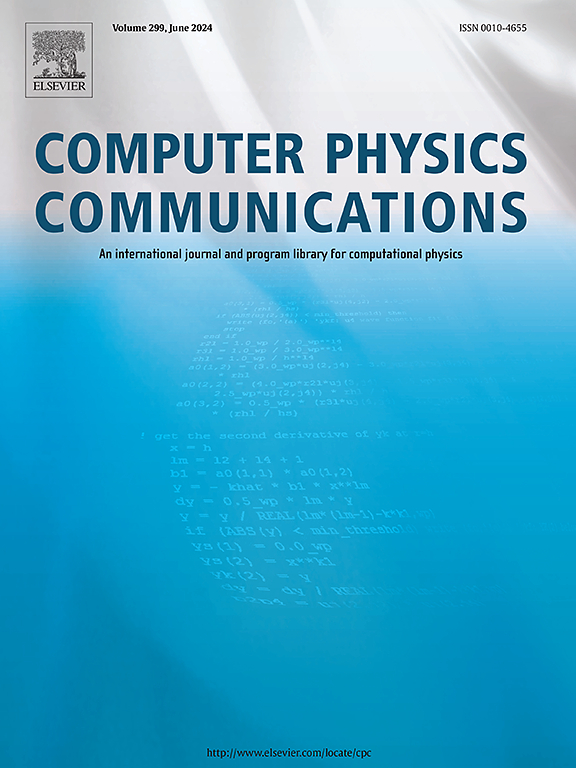一种新的基于THINC格式的轴对称两相流的CLSVOF方法
IF 3.4
2区 物理与天体物理
Q1 COMPUTER SCIENCE, INTERDISCIPLINARY APPLICATIONS
引用次数: 0
摘要
针对基于代数水平集与流体体积耦合(CLSVOF)方法的两相流模拟,提出了在轴对称坐标系下的界面捕获双曲线切线(THINC)格式。本工作的新颖之处在于考虑了径向和轴向两个独立的特征Heaviside函数。这种方法可以得到体积分数在两个方向上的平流通量的两种不同形式的直接解析表达式,而不像现有的笛卡尔坐标下的THINC格式所使用的相同形式。在各种轴对称平流试验中证明了所提出的CLSVOF方法的有效性,观察到所提出的轴对称THINC方案能够在保持所需界面厚度的同时保持高达机器精度水平的体积分数场,而不会产生任何不利的变形。为了确定这一新方案在实际问题中的行为,对充分不同的两相流动进行了全面的验证研究,如静态液滴,液滴振荡,液滴下降,气泡上升和液滴合并。结果表明,所提出的代数CLSVOF方法具有标准几何CLSVOF方法的鲁棒性和准确性,从而为实际场景中的数值实现提供了一种简单的方法。本文章由计算机程序翻译,如有差异,请以英文原文为准。
A novel THINC scheme-based CLSVOF method for axisymmetric two-phase flows
This paper is on proposition of a THINC (Tangent of the Hyperbola for INterface Capturing) scheme in axisymmetric coordinate system for an algebraic Coupled Level Set and Volume of Fluid (CLSVOF) method-based simulation of two-phase flows. Novelty of the present work lies in consideration of two separate characteristic Heaviside functions in radial and axial directions. Such an approach is shown to yield two distinct forms of direct analytical expression for the advection fluxes of volume fraction in both directions unlike the identical forms used in the existing THINC schemes for Cartesian coordinates. Effectiveness of the proposed CLSVOF method is presented on various axisymmetric advection tests, where it is observed that the present axisymmetric THINC scheme is capable of conserving the volume fraction field up to machine precision level while maintaining the desired interface thickness without any adverse distortions. To ascertain the behavior of this novel scheme for practical problems, a comprehensive validation study is performed for sufficiently different two-phase flows like static droplet, droplet oscillations, droplet fall, bubble rise, and droplet coalescence. It has been demonstrated that the proposed algebraic CLSVOF method emulates the robustness and accuracy of the standard geometric CLSVOF methods, thus facilitating a straightforward approach to numerical implementation in practical scenarios.
求助全文
通过发布文献求助,成功后即可免费获取论文全文。
去求助
来源期刊

Computer Physics Communications
物理-计算机:跨学科应用
CiteScore
12.10
自引率
3.20%
发文量
287
审稿时长
5.3 months
期刊介绍:
The focus of CPC is on contemporary computational methods and techniques and their implementation, the effectiveness of which will normally be evidenced by the author(s) within the context of a substantive problem in physics. Within this setting CPC publishes two types of paper.
Computer Programs in Physics (CPiP)
These papers describe significant computer programs to be archived in the CPC Program Library which is held in the Mendeley Data repository. The submitted software must be covered by an approved open source licence. Papers and associated computer programs that address a problem of contemporary interest in physics that cannot be solved by current software are particularly encouraged.
Computational Physics Papers (CP)
These are research papers in, but are not limited to, the following themes across computational physics and related disciplines.
mathematical and numerical methods and algorithms;
computational models including those associated with the design, control and analysis of experiments; and
algebraic computation.
Each will normally include software implementation and performance details. The software implementation should, ideally, be available via GitHub, Zenodo or an institutional repository.In addition, research papers on the impact of advanced computer architecture and special purpose computers on computing in the physical sciences and software topics related to, and of importance in, the physical sciences may be considered.
 求助内容:
求助内容: 应助结果提醒方式:
应助结果提醒方式:


